IDEX Online Research: Jewelry Price Inflation Slips Slightly At Supplier Level in July (Full Analysis)
August 29, 11
(IDEX Online) – While jewelry retail prices rose to record levels in July, supplier prices of jewelry slipped slightly from levels. However, both retail and supplier jewelry prices were up substantially over the same month last year, according to new government data.
Detailed Figures Reveal Underlying Trends
The table below summarizes inflation in the U.S. jewelry industry for July. The JCPI is the Jewelry Consumer Price Index and the JPPI is the Jewelry Producer Price Index.
Inflation Component July 2011 vs July 2010 July 2011 vs June 2011 Retail – JCPI Retail Jewelry & Watches +10.6% +1.5% Retail Jewelry +11.9% +1.5% Retail Watches +2.8% +1.4% Supplier – JPPI Supplier Jewelry & Watches +14.6% (0.8%) Supplier – Precious Metal Jewelry +17.9% (1.6%) Supplier – Watches +2.2% +0.1% Jewelry Commodities * Polished Diamonds +25.0% +5.6% Gold +31.8% +2.9% Platinum +15.3% (0.5%) Silver +111.1% +5.9% * Diamond jewelry sales represent between 40 percent and 45 percent of the market, while gold
jewelry sales have declined to about 8 percent of the total market. Both platinum and silver
jewelry each represent about one percent of the total market.
Disparity Between Retail & Supplier Prices Closes Slowly
One bit of good news: retail jewelry prices in the first seven months of 2011 have been rising much faster than in the past, so the gap between retail and supplier prices is closing, though very slowly. It is clear that jewelry retailers are no longer willing to absorb margin-robbing supplier price increases.
The graph below summarizes the recent disparity between retail jewelry price inflation and suppliers’ jewelry price inflation. Beginning in November 2010, retail prices (green bars) began to rise. By January 2011, the rate of retail price inflation was closing in on the rate of supplier price inflation. However, the large jump in producer prices in both June and July far outpaced retail jewelry price inflation, as the graph illustrates.
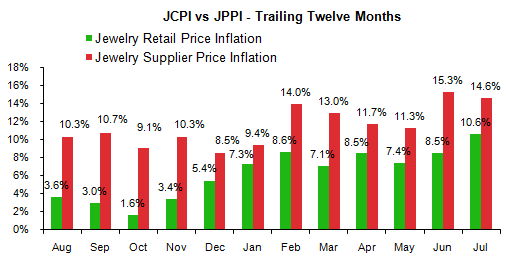 Source: BLS |
Sharply higher gold and other precious metals prices are pushing suppliers’ prices for precious metal jewelry higher at a faster rate than other sub-categories such as precious stone jewelry. The graph below compares suppliers’ inflation rate for precious metal jewelry versus all jewelry at the supplier level.
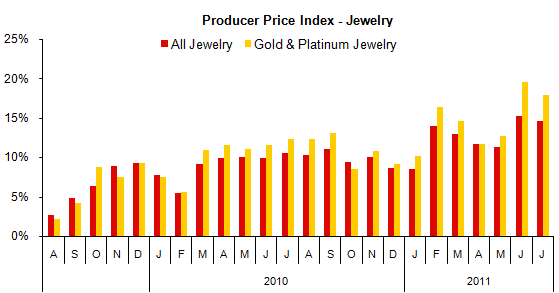 Source: BLS |
Watch price inflation at the supplier level picked up sharply in April, a trend which has continued for the past four months through July. Between October 2010 and March 2011, watch prices at the supplier level were nearly static – near current levels – as the graph below illustrates.
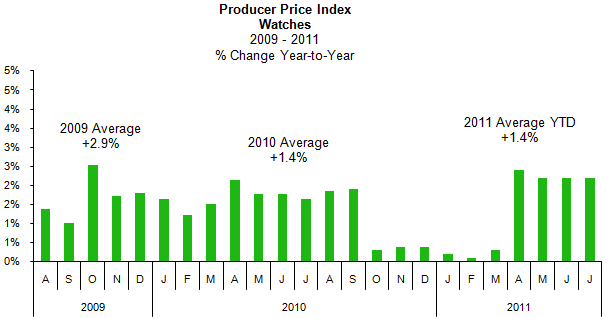 Source: BLS |
July Retail Prices Soar in July
Jewelry prices in retail stores, as measured by the JCPI (Jewelry Consumer Price Index) rose at a robust near-record rate of 10.6 percent in July, well above historic levels. This translated into a JCPI of 167.8, a record level. The index has a base of 100 in 1986. This means that jewelry retail prices have risen 67.8 percent over the past 25 years, with most of the inflation coming in the late 1980s as well as the past couple of years. For most of the 1990s and early 2000s, there was virtually no retail price inflation for jewelry.
The graph below summarizes the inflation trend for both jewelry and watches on a monthly basis. The solid upward trend is clear.
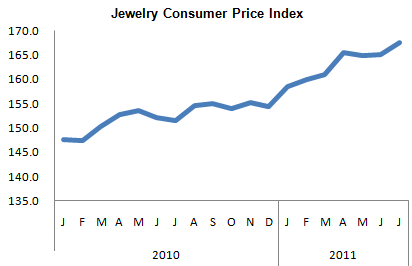 Source: BLS |
The graph below illustrates the inflation rate for the two major components of the JCPI (Jewelry Consumer Price Index) – jewelry and watches – as compared to the overall index. Watches had been showing price deflation at the retail level in 2010, but this trend changed in 2011, as the graph below illustrates. Higher watch prices are being driven by rising diamond and gold prices, since both commodities are important components of high-end watches.
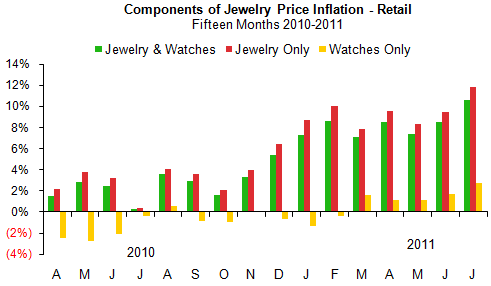 Source: BLS |
Outlook: Inflation Is Here, Until the Price Bubble Bursts
Are prices headed higher because of real demand? Or, are merchants pushing prices higher in an effort to recover sales and profits lost during the recession of 2008-2009? If it is the former, inflation is here to stay. If it is the latter, a price bubble is forming, and it will burst. When prices rise as quickly as they have recently, our sense is that there is potentially a price bubble.
In the U.S., Federal Reserve officials traditionally watched inflation closely. However, the most recent announcements from the Federal Open Market Committee suggest that the governors are less worried about inflation, but more worried about the lack of economic growth. As a result, they have signaled that interest rates are likely to remain near zero for the next two years, regardless of the impact on inflation.
For the jewelry industry, 2011’s inflation numbers indicate that inflation is real. It appears that jewelry merchants are trying to recoup margins – hopefully, not at the wrong time – just as the economy is teetering on the edge between a slow recovery or a double-dip.